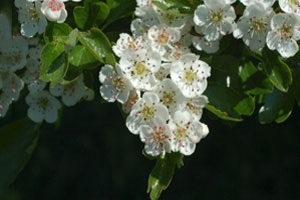Hawthorn
 “Ne’er cast a clout till May is out,” the saying goes. Many believe this to mean that you can be “clouted” or caught out by a cold spell up until the end of the month of May, but in fact the old English meaning of the word clout, means cloth or clothing.
“Ne’er cast a clout till May is out,” the saying goes. Many believe this to mean that you can be “clouted” or caught out by a cold spell up until the end of the month of May, but in fact the old English meaning of the word clout, means cloth or clothing.
Another, longer version of the saying is: “Button to chin, till May be in, cast not a clout, till May be out.” So what it actually means is, don’t take off your winter clothing until May is over! But does it really mean the month of May or the blossom of the Hawthorn tree – also known as May?
“Here we go gathering nuts in May” – a very well-known line from the nursery rhyme, seems to be an odd time of year to gather nuts! What it originally said was, “Here we go gathering KNOTS of May”, meaning bunches of May blossom to make garlands in celebration of May Day.
Hawthorn blossom has always played an important role in this celebration, not only as the main flower used to beautify the May Queen, but it is also traditionally the key decoration used on the Maypole. The Maypole and Maypole dancing symbolises renewed life and the bringing together of people in marriage – the ribbons joining together as the dancers go around the pole. Hawthorn is strongly associated with a fresh start and well-being – probably why the Pilgrim Fathers decided to call the boat carrying them to a new life in America – the Mayflower.
Wherever Hawthorn grows it has long been considered a tonic for the heart. It is believed to not only relieve stress, fear, negativity and palpitations but also opens up the heart to love. Although all parts of the plant are used, it is the berries that once dried, are put into a cup with boiling water, left to simmer for twenty minutes and then the liquid infusion is drunk. The berries do contain antioxidents and are also rich in vitamin C, both of which help to keep the veins and capillaries functioning properly. Indeed, research carried out in the 1980s in Germany, using extensive scientific experiments, found that the chemicals contained in hawthorn berries were hugely helpful in reducing blood pressure and general heart problems.
Of course the most famous Hawthorn in this country is the “Holy Thorn” of Glastonbury. It is said to have grown there when Joseph of Arimathea, who came to England shortly after Jesus died, stopped on Weary-all hill (now called Worral hill) and pushed the Hawthorn staff that he had brought with him from Palestine (this variety of Hawthorn does grow there) into the ground and left it there. It grew into a tree that flowers at both Christmas time and again in May, and although the original tree no longer exists, other related thorn trees around the Cathedral do still flower twice a year.
To me one of the finest sights in the glorious month of May is a Hawthorn tree in full flower, the blossom alive with attendant bees and flies attracted to the scent – which men are meant to prefer as it is supposed to resemble the natural scent of a female! So, take time this May to go and have a close look at a mature Hawthorn tree – and drink it in, as it will not only refresh your heart, but your soul as well!
Peter Thompson
Advisory

Download Peter Thompson's essential 26-page book, featuring beautiful photography and detailed profiles of Britain's wildlife
Download FREE >